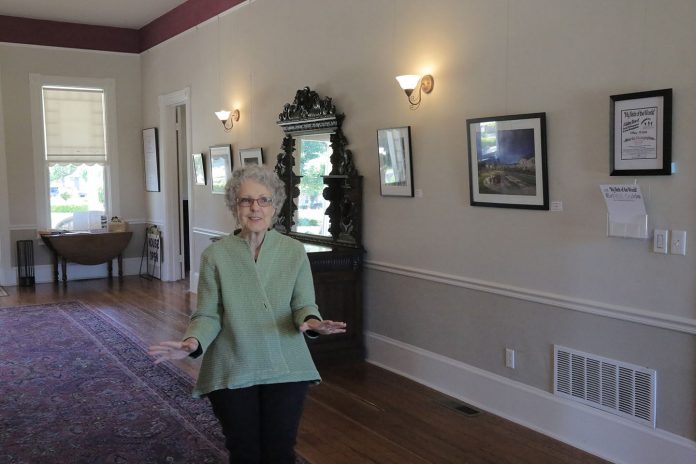
<
As Morgan Hill continues to grow and embrace the latest in high technology and other commercial pursuits, there remains a small—yet vital—slice of town that predates the city’s founding, to which a dedicated group of volunteers is intent on preserving for future generations.
<
The Hiram Morgan Hill House, built in 1884 by the city’s founder, sits in its original location at what is now 17860 Monterey Road. Preserved as the only local property listed in the National Registry of Historic Landmarks, the house serves as the centerpiece of Villa Mira Monte, a 2.5-acre site that includes the Acton House (built in 1911) and “history trail” that features more than 200 rose bushes and 100 ground tiles that signify important milestones over the last century-plus.
<
Villa Mira Monte has been maintained and operated by the nonprofit Morgan Hill Historical Society since the early 1990s, when the board of directors, volunteers and donors undertook a five-year renovation of the Hiram Morgan Hill House.
<
Now, the MHHS—run primarily by the 12-member board—hosts field trips for local school children at Villa Mira Monte, as well as a busy schedule of fundraising events that are always open to the public. These include wine tastings, semi-annual boutiques, tea sessions and extravagant parties such as the upcoming “Prohibition Party” June 25.
<
Owing to the success of the MHHS’ first extensive renovation and the increasing popularity of the site, as well as preservation mandates placed on the entire Villa Mira Monte site by the NRHL, the society has undertaken a renewed push to ask the public to urge city officials to fund a proposed facelift to the property that will improve it forever as a central gathering site.
<
“Because it’s a national landmark site, it has to be preserved in perpetuity,” explained MHHS President Kathy Sullivan on a recent tour of the property. “It’s time for our community as a whole to support this site.”
<
For the last few years, the MHHS has pleaded with the City Council for funding to implement the proposed improvements, expected to cost between $3 million and $4 million. Now this “partnership” with the city appears to be getting closer to fruition, as the city’s Recreation and Community Services Department is evaluating the proposal as part of its 2016-17 Master Plan, according to Morgan Hill Community Services Director Chris Ghione.
<
That plan will likely be complete by this fall, at which point city staff will present a recommendation to the council on whether to fund the Villa Mira Monte improvements, and by how much, Ghione added. The city’s Parks and Recreation Commission and—just earlier this week—Planning Commission have recommended including the project in the city’s five-year Capital Improvement Program. It’s up to the city council whether to fund the improvements.
<
“The historic resources the site brings are important to our community,” Ghione said.
<
The two-phase expansion would significantly enhance Villa Mira Monte’s capabilities as an event center, tourist attraction and public park, according to MHHS board members. The first phase would add infrastructure, including a paved parking lot and driveway, stormwater runoff and utility facilities, lighting, fencing and new landscaping behind the Hiram Morgan Hill House.
<
The second phase of the expansion would add two new structures. One would house a “multi-purpose” community room—which could host workshops, classes, MHHS meetings (there are about 400 paying members of the society) and office space—as well as historical archive storage. This building could be rented out to nonprofits or other community groups, Sullivan said.
<
The second structure would house restrooms and a Department of Public Health-certified kitchen, allowing volunteers or caterers to prepare food on site.
<
Finally, the MHHS plans to build an outdoor pavilion behind the Hiram Morgan Hill House—where the gravel parking lot is now—that could seat up to 150 people and be suitable for weddings, concerts or similar public or private events.
<
A key aspect of the expansion project is to improve and beautify the “line of sight” from the railroad tracks behind Villa Mira Monte to the Hiram Morgan Hill House. Sullivan—as well as MHHS Vice President Jean Haneke and board members Mike Monroe and Nancy Reynolds—explained that when Hiram Morgan Hill, his family and other visitors traveled to the site (a vacation home), the train would drop them off at what was then known as “Hills Ranch.”
<
Now, for about 100 yards between the Morgan Hill House and the railroad tracks is a field of weeds.
<
Villa Mira Monte has benefited from public funds in the past. When MHHS became the site’s caretaker around 1992, they gained about $350,000 from the Morgan Hill Redevelopment Agency toward a $525,000 renovation of the Hiram Morgan Hill House. That included straightening out the home’s floor and frame—after it had been vacant for several years—and installing a new foundation.
<
They also did interior renovations and furnished the home. Developer Charles Davidson donated about $75,000 to that effort, and contractors contributed work at no cost to the MHHS or city.
<
Former Mayor Dennis Kennedy’s wedding reception in 1998 was the first event at the Hiram Morgan Hill House after its renovation was completed.
<
In their latest public engagement effort, board members stress how important Villa Mira Monte is as a repository of the history that defines Morgan Hill as a community. They are asking residents to attend upcoming city council and commission meetings, and write letters encouraging the elected and appointed officials to support funding for the Villa Mira Monte improvements. For more information, visit morganhillhistoricalsociety.org.
“Let the city know you value your history,” Sullivan said. “This is one of the few houses remaining in the country, and even in the world, that was built by the namesake of the city it’s (located) in.”







